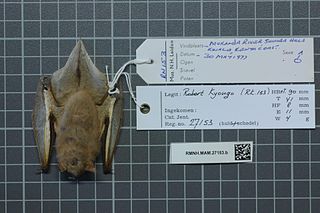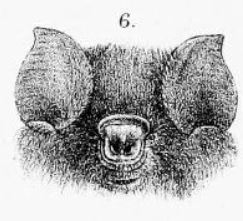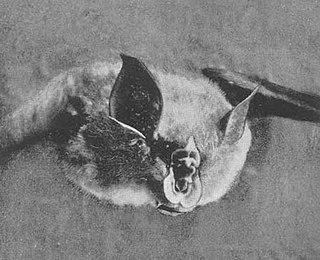
Megalagrion is a genus of damselflies in the family Coenagrionidae It contains approximately 26 species, all of which are endemic to Hawaiʻi.
This timeline of extinctions is an historical account of species that have become extinct during the time that modern humans have occupied the Earth.

Rendall's serotine is a species of vesper bat. It is found in Benin, Botswana, Burkina Faso, Cameroon, Central African Republic, Chad, Republic of the Congo, Democratic Republic of the Congo, Gambia, Ghana, Kenya, Malawi, Mali, Mozambique, Niger, Nigeria, Rwanda, Senegal, Sierra Leone, Somalia, South Africa, Sudan, Tanzania, Uganda, and Zambia. Its natural habitats are dry savanna, moist savanna, subtropical or tropical dry shrubland, and subtropical or tropical moist shrubland. It is threatened by habitat loss.
The velvet flycatcher is a species of bird in the family Monarchidae. It is endemic to the Bismarck Archipelago.

The Somali hedgehog is a species of mammal in the family Erinaceidae. It is endemic to Somalia. The Somali hedgehog is nocturnal.

The Kahuzi swamp shrew is a species of mammal in the family Soricidae found in the Democratic Republic of the Congo. Its natural habitat is swamp. It is threatened by habitat loss.

The Usambara shrew is a species of mammal in the family Soricidae. It is endemic to Tanzania. Its natural habitat is subtropical or tropical moist montane forests. It is threatened by habitat loss.

The greater stripe-backed shrew or stripe-backed shrew is a species of mammal in the family Soricidae. It is endemic to China. It is threatened by habitat loss. The Greater stripe-backed shrew also shares 97% of its DNA with humans.

The sooty roundleaf bat is a species of bat in the family Hipposideridae. It is found in Cameroon, Democratic Republic of the Congo, Ivory Coast, Gabon, Ghana, Guinea, Liberia, Nigeria, Sierra Leone, and Uganda. Its natural habitats are subtropical or tropical moist lowland forests and moist savanna. It is threatened by habitat loss.

Veldkamp's dwarf epauletted fruit bat is a species of bat in the family Pteropodidae. It is monotypic within the genus Nanonycteris. It is found in Benin, Cameroon, Central African Republic, Ivory Coast, Ghana, Guinea, Liberia, Nigeria, Sierra Leone, and Togo. Its natural habitats are subtropical or tropical moist lowland forest, subtropical or tropical mangrove forest, subtropical or tropical moist montane forest, dry savanna, and moist savanna. It is threatened by habitat loss.

Lander's horseshoe bat is a species of bat in the family Rhinolophidae found in Africa. Its natural habitats are dry savanna, moist savanna, and caves.

The Bushveld horseshoe bat is a species of bat in the family Rhinolophidae.
Coenagriocnemis is a genus of damselfly in the family Coenagrionidae. The whole genus is endemic to the Mascarene Islands.
Helicia insularis is a species of plant in the family Proteaceae. It is endemic to Papua New Guinea. It is threatened by habitat loss.
Helicia neglecta is a species of plant in the family Proteaceae. It is endemic to Papua New Guinea. It is threatened by habitat loss.

The pale martin or pale sand martin is a small passerine bird in the swallow family.

The New Georgian monkey-faced bat is a recently described species of megabat endemic to the Solomon Islands, more specifically New Georgia and Vangunu Islands. It is presumably extinct on Kolombangara Island, and remaining population on other islands are threatened by habitat loss and hunting. Consequently, it is considered vulnerable by IUCN. In 2013, Bat Conservation International listed this species as one of the 35 species of its worldwide priority list of conservation.
Bat Conservation International (BCI) is an international nongovernmental organization working to conserve the world's bats and their habitats through conservation, education, and research efforts.

The Flores monarch is a species of bird in the family Monarchidae. It is endemic to the western half of the island of Flores in Indonesia.

The southern big-eared brown bat is a species of bat from the family Vespertilionidae. Although current taxonomy treats the southern big-eared brown bat as a separate species, it is often treated as a subspecies of the small big-eared brown bat. It lives in the forests of southern Argentina and Chile; though the population of the bat in the southern part of its habitat is low, there are no major concerns to justify anything lower than a Least Concern rating in the IUCN Red List. There is some habitat destruction, as well as trouble with beavers in Tierra del Fuego.














